#Treasures of Africa Collection
Explore tagged Tumblr posts
Photo


Tatu Barbie Doll by Byron Lars Treasures of Africa Collection Limited Edition
Mbili Barbie Doll by Byron Lars Treasures of Africa Collection Limited Edition
Barbie® Collectibles by Mail - Summer 2003
#Barbie Collectibles#Barbie#Barbie Doll#Barbie Collectibles by Mail#Treasures of Africa Collection#Tatu Barbie#Mbili Barbie#Byron Lars
101 notes
·
View notes
Note
Hello hello, sending hugs as always!
I was hoping you maybe be able to give me some inspiration for a small series of food photos I'm assembling for Channukah! I'm doing an 8 part series celebrating the different groups within Judaism to 1. Be loudly and proudly Jewish at this current time, and 2. raise awareness for non-ashki Jews. In the UK it's super hard to find many non ashki peeps which makes it hard to chat to people about other classic Channukah foods, but I was wondering if you knew of any particularly good ones (that aren't latke or sufganiyot)? Would hugely appreciate any suggestions you have!!
Hi darling, sending you the biggest hugs right back! <3
Oooh, Hanukkah foods! I'm not gonna lie, some of my fave Jewish foods come from this holiday. With your permission, I'll give a small introduction, just for anyone reading, who might be unfamiliar with Hanukkah, and curious... and also talk about some of the lesser known Hanukkah food traditions among European Jews, too.
So during Hanukkah, we celebrate a miracle that happened with the oil at the Temple in Jerusalem. After the Jews defeated the occupying Greek forces that had desecrated our Temple, we wanted to light again the eternal flame of the Menorah (the Temple candelabra) with olive oil, but after the destruction caused by the Greek forces, there was only enough left for one day, and it would take 8 days to get more oil. The miracle is that somehow, that small amount of oil lasted for the whole 8 days, meaning the light didn't go out again. To remember this miracle, we eat food fried in oil! Being Jewish is so good for your health. XD
In shops and bakeries around Israel, there are already sufganiot being sold. They are YUMMY, and while some people call them "the Jewish donuts," I can say that after having eaten American donuts, I def think sufganiot are way yummier (in part 'coz they're not as "heavy" because the dough it's made of is fluffier? More... airy? Not sure how to say it, but I hope you get the idea). Also, you don't get robbed, because someone made a hole in the middle of the sufgania, taking out nearly half of it. The traditional type has strawberry jam injected inside, and sugar powder on top, but in Israel there are some crazy fancy kinds, and every year they seem to become more extravagant.
Traditional sufganiot (you can see a bit of the jam on top, but half the fun is biting and getting to the "treasure" of lots of jam at the center of the sufgania):

Fancy sufganiot:


Then there's the latkes, or as they're called in Hebrew, levivot. They're like savoury pancakes made out of potatoes, and obviously they're fried in oil.
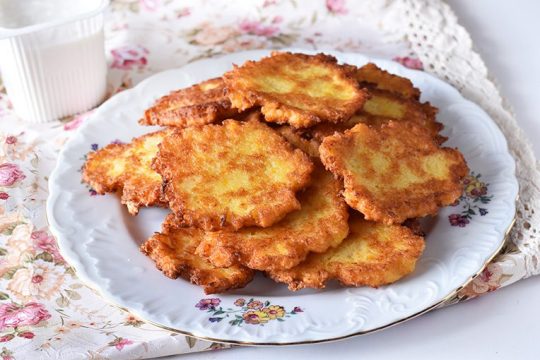
In many Jewish communities, there was a custom of giving kids special pocket money for Hanukkah. In Israel, this "money" is given in the form of chocolate "coins." I freaking loved this as a kid! It was fun unwrapping the "coins," eating the chocolate, and then (assuming I was careful when peeling them off), make a collection of the different "coins," or just play with the wrap.

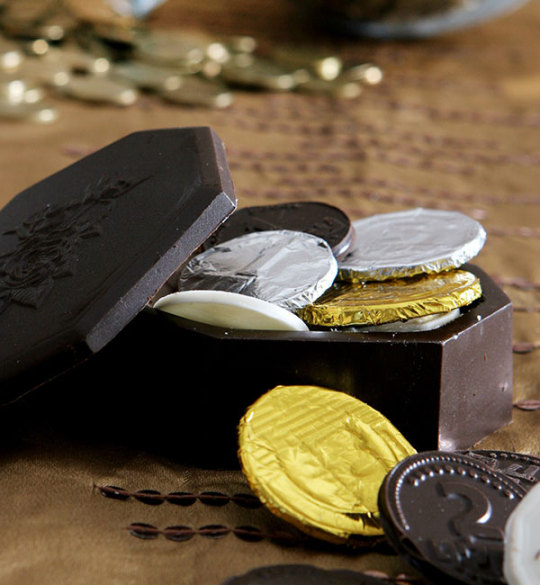
Greek Jews used to make a bread from potatoes and yogurt:

Georgian Jews made levivot out of corn flour (sometimes filled with cheese), or out of potatoes AND nuts, giving it the shape of a big omelette. Here's the corn flour version:

Czech Jews had a custom saying goose is the best meat, so for Hanukkah, they often ate goose related dishes. For example, they would make levivot from potatoes, eggs, sugar, lemon and goose fat.
French and Swiss Jews would make levivot out of apples.

The Jews of Iraq, Algeria and Buchara (which is in Uzbekistan) used to put the Hanukkah pocket money for the kids inside honey cakes. In Algeria and Buchara they also sometimes made levivot with meat added inside.
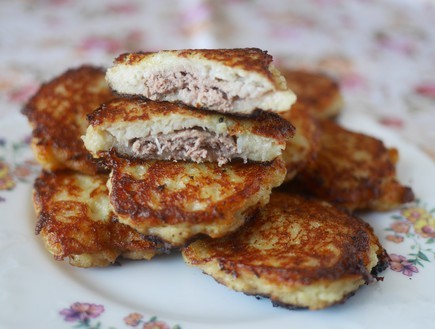
The Jews of Romania and Austria used to light potato Hanukkah candles! This was likely because they were so poor. Still, a pretty cool thing, when you can light your candle, and eat it (or at least a part of it), too.

In northern Africa, Jews used to make a type of cookie called Debla (sometimes nicknamed "dough roses"), which originated in Libya. They're usually eaten with a sweet syrup. It's more of a Purim dish (the equivalent of Hamantaschen), but was sometimes prepared for Hanukkah as well. Traditional Debla:
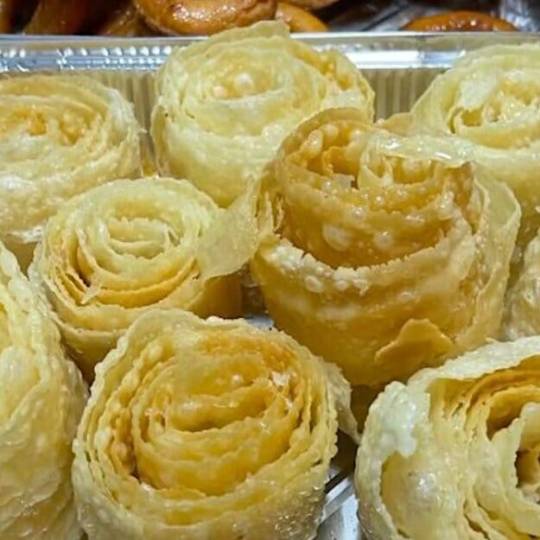
And a slightly "fancier" Israeli version:

Okay, maybe my fave Hanukkah dish! It's called sfinge (the 'ge' is pronounced like in "sponge"), and it's basically the Moroccan sufgania, which later became popular among Tunisia and Libya Jews, too. It can be round with a hole in the middle, it can be in the shape of a ball, while Libyan Jews make it flat. It's eaten with either honey or sugar powder, but again, in Israel fancier versions developed... I'm not a great cook, so IDK to explain why, but it's even fluffier than the sufgania, and that's why it's my personal fave.
Traditional sfinge with honey:

With sugar powder:
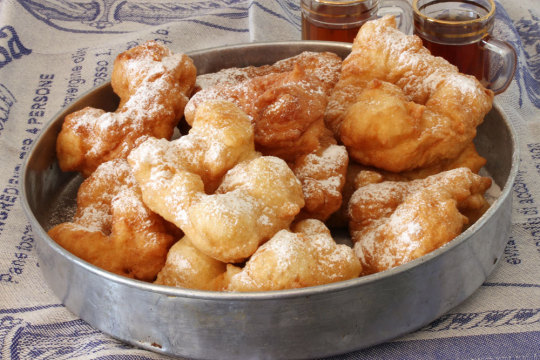
Israelis always having to make everything fancier:
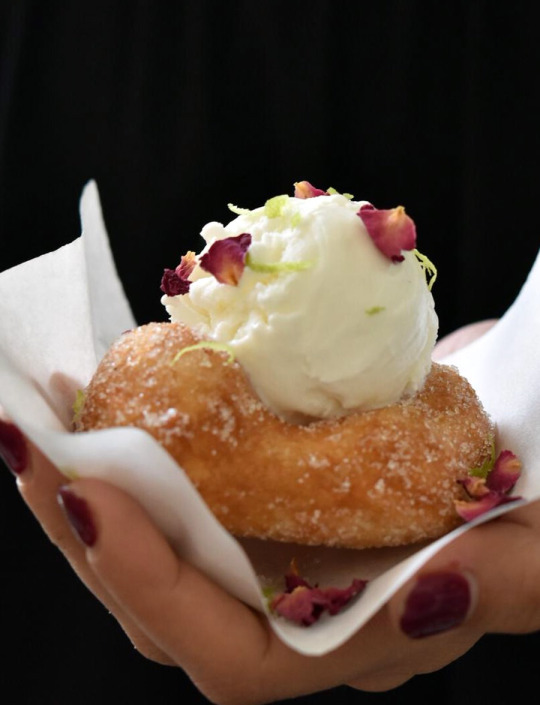





They even made a savoury version of flat sfinge...

I hope this helps! Have a wonderful day, darling! xoxox
#judaism#jewish#jew#jumblr#frumblr#ask#classical-memeician#jews#jewish stuff#hanukkah#jewish history#jewish food#foodgasm
347 notes
·
View notes
Text
Better have a good enemy than a crazy friend (cont.)
I re-used Rommel from a previous work, because I like this Rommel but dissatisfied with the other work :/

Two Scorpios. INTERESTING.
The whole thing started with this post. The said friend finally agrees to help a little bit with fanfic. She doesn't speak English and I'm clueless with omegaverse; that is a problem LOL.
Here goes nothing.

They’ve been through this ritual for… how many days now? Making love in abandonment till the slim golden dawn undulates across the desert’s pale dunes. The intercourse continues well into morning hours, when the sun begins to burn their fragrant skins a little, and the inside of Rommel’s lower belly laden with his enemy’s alpha seeds.
“Indeed, this grand scenery does not exist in Europe.” Monty says as he sits up, “here, in Africa, this is the hill I am willing to die on.” Then, he smiles at his own military humor. Rommel lazily eyes him, still basking in post-coital bliss. He could only make out “Europe” and “Africa” from the other man’s monologue.
Montgomery along with his squad captured Rommel when the daring Fox got too close to the British base, during a foolhardy scouting mission with limited supplies of his necessary medicines. Once Montgomery accidentally triggered his enemy’s omega response, the Fox becomes Monty’s willing POW-- even his iron will had to bend before this primitive drive. Rommel knew it was his own blunder, and a terrible one. He has no right to complain.
Rommel grabs the English man’s hand and places it on his abdomen, muttering a few German words. Monty playfully wanders his hand downwards between his thighs. The Fox snaps it back, places Monty’s hand, yet again, on his flat belly. Seeing Montgomery in the mood of messing around, Rommel gives up communication, punches him squarely in the face, gets up, collects his clothes, promptly walks off towards the general direction of the Afrika Korps.
Montgomery does not treat him like a POW. It’s his own blunder. Rommel thinks to himself in utter frustration.
“Wait! I apologize! What is it you want to say? I'm listening!” Montgomery catches up to him, his face freshly swollen from the punch. He has nothing on him but his iconic black beret and underwear, a rather pathetic sight for this good general, but one that gives Rommel the illusion that the otherworldly love between enemies is possible.
Rommel sighs, damn this language barrier, damn that this barrier is powerless against enemy penetration into his soul. He carefully brings out a medal from his uniform front pocket, places it in Montgomery’s palm. It is both small and light and incredibly heavy, its color creamy porcelain blue.
“I am a man of duty, both to my country and my wife. I cannot further blacken my already tainted conscience.” He says, in a tongue he knows the other man does not comprehend, “But I do owe you. I’ll bring this child to you and reclaim my honor, eventually. I’ll be a part of their life until the very end of mine. This embodies my highest promise to you.”
Montgomery could tell it is the renowned Pour le Merite, prized treasure of all the 3rd Reich's officers. His heart sinks a little.
“Here.” Monty takes the golden badge off his beret, his movements clumsy with haste. “This represents me, all those politicians, and the civilians back in London recognize my status by this symbol. May it be with you, as though I am with you.”
“Thank you.” In a low voice, he speaks the only English he knows. Rommel's intention is to come back for his medal, but Monty has a hunch, they'll never see each other again.
///
Tension runs high in the OKH headquarters. Both Halder and von Brauchitsch are absent. Hitler throws the papers flying across the mahogany table. Apart from that, the room is eerily silent.
“I am not going to approve of your discharge, Field Marshal Erwin Rommel.”
“Since I am also implicated in the conspiracy case, Führer, I…”
“Don’t Führer me, you traitor, you whore!” Hitler snaps at him, already showing signs of nervous breakdowns, “Goebbel has been working his head off to promote you as our Reich’s prominent alpha hero! Only a few of us knew what you really are. You have that little extra bit to make you a whore.”
“There never have been any intention in my heart to betray you, Führer . I am speaking with my soldierly honor and utmost honesty. You knew me.”
“You used to be my personal security, but that was in the past. I don’t think I know you anymore.”
True, the trust has been broken completely. Rommel holds loyalty to his country, but not to this angry mess in front of him. Not anymore.
The Führer’s bloodshot eyes darts around his neck: “where is your blue cross Pour le Merite? What is that thing on your chest?”
“It is Field Marshal's gold wire embroidered badge…” Rommel paused, “of the British Army.”
“so you are literally in bed with Bernard Montgomery. I mean, physically and who knows what else, Is that so?”
Rommel understands at this point, in Hitler’s eyes, it is further confirmation of high treason. This whole conversation is a demonstration of his political naivety.
“Who else knows about this... scandal? Does Von Rundstedt know? Your wife Lucy?” Hitler motions the slightly visible bump in Rommel’s belly. Rommel shivers in disgust. He feels exposed.
“My trustworthy chief of staff Alfred Gause does. No one else.”
“Gause runs a good staff. He does not keep a good eye on you for me, however.” Hitler coldly comments, “Does HE know? I mean, the other father.”
“I cannot confirm that.” Rommel whispers.
“I bet that Brit doesn’t speak even a little bit of German. You may as well fuck all day and not exchange a word.” The Führer’s voice is loaded with irony. Rommel falls into a grey silence, a hint of red flies onto his cheeks.
“Old friend,” Hitler changes his tone, a manipulator that he is, “I could still find it in me to forgive you, on one condition: you take a bite of one of these bitter medicines.”
Two black boxes, one contains a cyanide pill, the other an abortion tablet.
“Choose, it’s Führer’s order.”
Rommel chooses; hands steady, his gaze dark. The choices are cruel, but one of them allows him to not break his promise. He’s a man of duty, after all.
“Don’t you beg for mercy?”
“I obey your order, mein Führer.”
He leaves with the pill option. An SS officer escorts him outside.

Friend- Hehe I am satisfied with the historical accuracy.
Me-

#wwii germany#3rd reich#erwin rommel#desert fox#fanfic#bernard montgomery#omegaverse#there is no historical accuracy here thank you very much#wehrmachtblr
40 notes
·
View notes
Text
Wish Rewrite
Once a year my aunt and her family come to visit the rest of us and we do something together. Her little daughter really wanted to see the new Disney movie, so we all went with. I have thoughts, but everything that needs to be said, probably has somewhere and that’s not why I’m here.
Just for fun I started to come up with two complete rewrites, however. One is committing to Magnifico as a sympathetic antagonist, by fleshing out his backstory and motivations more. The other is him being a more classic villain, along with the earlier concept of his wife being evil as well. Still working out the classic villain version, besides there are already several rewrites based on that premise from what I’ve seen, so that version I upload some other time, if I find the time to write it down.
One other thing to note, I feel Asha should have been a princess; of all the callbacks to classic Disney movies that would not have felt shoehorned in, how was she not a literal princess. Her family is half Iberian, half North African? Okay, Magnifico is from Iberia, we change Amaya’s design a little and have her be from Northern Africa, done. Now we can cut out grandpa and mum, who really didn’t do much in the movie, the conflict gets even more personal and we have a bit more time to flesh out the characters.
Wish with a Sympathetic Antagonist
Let’s start with the backstory:
Once upon a time, a region on the Iberian Peninsula suffered under a horrible drought. The citizens begged for rain, until one night a star fell from the skies, to which the people felt drawn to. It seemed like their prayers had been answered, as even their deepest wishes began to manifest in close enough proximity and people figured out, the star’s power could also make them come true. But not all wishes were benign. Some people were suddenly forced against their will to love another, others became incurably sick as if cursed, others yet wished for power and soon fought those with the same ambitions. Or to claim the star for themselves.
A young Magnifico left to find a way to stop this madness and save his home, but when he returned a sorcerer his country had already gone up in flames and was completely devastated, all but abandoned. He trapped the star in a crystal, vowing to safeguard it until he found a way to be rid of it for good. Since the star is sentient, he was unwilling to simply destroy it (that’s more of a last option), but people were literally going mad over this power, so something had to be done, or other kingdoms would suffer the same fate. He moved to an island in the Mediterranean, but people found their way there, feeling drawn to the place, because the star’s powers were not completely concealed, it’s too powerful, more so than Magnifico actually, and even wishes still manifested as the orbs we’ve seen in the movie.
Magnifico kept the star itself a secret, and decided to collect the wishes, carefully granting only those he deemed safe, without dooming the island, haunted by what had happened to his home. It borders a bit on paranoia, like when seeing a wish, his first thought is “how can this be harmful?” and more often than not, he comes up with a scenario in his head, where even a benign seeming wish has some horrible consequence. He honestly doesn’t like fulfilling them, as a selection process is usually unfair in some way or another, aside from being time-consuming, while granting everything or the wrong thing could lead to disaster. Plus, he only has very limited control on how the star fulfills the wish, which means that in some cases the star acts like a monkey’s paw. Like you wish for money, but there is a difference between finding some hidden treasure in your backyard or your parents suddenly dying and leaving it to you in their will.
The star isn’t a malicious spirit though; it simply does its thing, granting the wish, but just like water, seeking the way of least resistance. It doesn’t have an understanding of good and evil. Best Magnifico can do is find specific enough wishes, or use his own magic to make them specific enough, so the star has less room for catastrophic interpretations. When granting wishes he does it as a show, and he knows how to put one on, to keep the people happy/content, so they let him continue his work in peace, rather than beg for every little thing, and pretends like it’s his magic doing it, to preserve order. He’s worried that if he loses control, or others learn of the star, everyone will go mad over this power again.
Still, he loves the adoration he receives. He was too late to save his home country, he failed in what he set out to do, when he first became a sorcerer, but here not only does he get to use his powers for their intended purpose, but is also celebrated for it.
However he needed help. After all, now there was a country to run; not his area of expertise, so Magnifico reached out to the nearest realms. He eventually made friends with a king/sultan in northern Africa, who helped him build his island into a proper kingdom and soon Magnifico fell in love with the sultan’s daughter, Amaya. Lucky for him she was also quickly smitten with him and after one of his visits returned with him to the island as his wife. Rosas soon thrived, developing into a trading hub, Magnifico could focus more on the star again, even began collecting other dangerous artifacts for safekeeping. And eventually, the happy couple had a daughter, Asha.
Now to the real meat, the actual story:
Asha grew up quite happy, but with very busy parents. They run the country, her mother actually being quite involved as well, to give Magnifico more time to deal with any magical problems that arise (and I very much include mythical monsters in that list) and his studies around the star. They still love her (and of course each other) dearly, but their parenting leaves something to be desired, in some areas.
Her dad, who is afraid of what will happen if he himself messes up, can be a bit perfectionistic and thus has little patience for his own or other people’s mistakes. That, along with him not trusting people that much (aside from his wife), leads to him having a “I know best”-attitude and a bit of vanity. Her parents do also have somewhat high expectations, when it comes to their daughter, teaching her early on how to act proper and starting to prepare her for role as princess and future Queen.
Let’s cut down the number of close friends (two or three will probably suffice), animal side-kick optional, and have the rest of the supporting cast be adults, mostly members of the castle’s staff, some of which spent more time with Asha as a kid than her actual parents. Now, once Asha is old enough, her father begins to teach her a bit of magic, something she was always fascinated by and honestly she just wants to spend more time with him. But since she’s still a kid she uses it in more playful manners, like concealing herself during hide-&-seek-games, which would also be a great opportunity to show Magnifico’s sillier and caring side. A scene to really show us that he loves his daughter and spending time with her, when he isn’t preoccupied with ten other things.
Once Asha becomes a teenager (still younger than she is in the movie), she’s ready to learn more and her father shows her what he’s been working on all these years. A spell that will banish the star back to the heavens. His work is almost completed; he only needs to figure out the final lines of the spell he’s been creating, one capable of overpowering the star, which has been able to resist his magic so far. Remember, he trapped it using a crystal, not via spell. He tells her what the star does, enticing people when they sense its presence, drawing out the deepest wishes to the surface until they manifest as one of those whish-orbs. Only then you can use the star’s power directly to make the wish within come true, though it’s not always certain how it comes true or if there will be a consequence, which finally explains to her why her father doesn’t make more wishes come true, something that had always bothered her as a kid.
The orbs are also the reason why most adults in the kingdom seem complacent, as many are simply waiting for theirs to come true during one of the ceremonies. They haven’t forgotten their wishes though, just lack the drive to pursue them, but returning them to the people is fruitless anyway, as soon enough the wish only gets drawn out again. So, they need to be kept save; destroy an orb and the wish within is destroyed as well, forever, and that’s when they forget. She now also understands why the star’s room was always so alluring, despite only know learning about it; until now, she, like the citizens, thought it was Magnifico’s own magic.
In addition he warns her to be careful, when she studies, as there are plenty of dangerous books that either hold unsafe spells, evil spirits, or harm those using or even just reading them. They are locked up in their own room for a reason, no touching, better yet, don’t even enter that section. Asha is certain she can hear something whispering, before he closes the door again, but hopes she’s imagining it. When she asks, why he keeps them in the first place, he explains that there are saver here, than out there in the wrong hands. He sees them as a similar threat to the star, so he collects any he finds. Unfortunately, destroying them would only unleash the powers held within, which could be devastating, so it’s a problem he can focus on, once the star has been dealt with. He tells/teaches her, in case he should not be able to finish his work in his lifetime and needs someone he can trust to continue in his stead. He doesn’t want to pass this burden on to her, but he has to prepare for that eventuality.
Asha is determined to meet all lofty expectations her parents have and continues studying, learning more spells and how her father managed to trap the star in the first place. Seeing her father continue to struggle with his research, even seeing him fail in sending the star back and literally losing sleep over it, Asha eventually gets the idea to wish for the star to return to the heavens (remember she younger in this version); surely such a simple wish won’t have consequences or will be fulfilled in a convoluted way. She also hopes that once the star is gone, her dad will finally be free from this burden, and maybe in the end both her parents will have more time to spend with their daughter…as a family. So, one night she sneaks out, to the room where her father keeps the trapped star, dispels the wards (using her father’s books/notes) and breaks in.
However, as she tries to draw out that one specific wish by force, so the star can fulfill it, she messes up. At first she draws out the wrong orb, as her deepest wish is technically her family being together, sending the star back is just a means to it. Which is also why she doesn’t use that orb; if the star fulfills that wish by making her father just forget or not care about the star, it would be bad for everyone.
Thus, she lets the orb float away for now, but as she tries harder, she accidently draws the star out of the crystal instead and it disappears into the night. Asha panics and is terrified to tell her parents, especially her father, as many kids are, when they mess up. Therefore, she gets her best friends to help instead and goes after the star, hoping to recapture it in another crystal before it can do any damage, or people go mad over it.
Magnifico of course is alerted about the break in and doesn’t suspect his daughter, because he can’t believe she would be that foolish (he hasn’t been around kids that much) and panics when not only the star is gone, but Asha as well. His conclusion is that someone, possibly another sorcerer, broke in, stole the star, and has his daughter as a hostage, because evil magic-wielders kidnapping princesses is kind of a thing in fairy tales. He begins his search, enforces a lockdown, so no one can come across the star or whoever stole it, and creates a spell-circle around the island, like a seal, so no one can enter or leave without his say-so. Amaya tries to calm him down, tells him how he’s rushing to the worst possible conclusions again, but he’s already having flashbacks to what happened in his home country, his family there, and now not just the kingdom is on the line, but his daughter…rational thinking is becoming difficult. He lost everything once already, and that was before he was a parent. He departs promising to get their daughter back and claiming that he would destroy the star before letting anything happen to her. Amaya flinches at that, since she also knows that the star is a sentient being, but knowing that in this state arguing with him won’t help, just reassures him in the calmest possible manner (despite her own worries/fears) that she trust him and has no doubt he’ll get Asha back safe.
Meanwhile, Asha and friends catch up with the star, which is granting wishes to random people in the countryside and it’s causing a bit of chaos. They even see what happens when an orb gets destroyed; one man grabs another’s wish and literally crushes it in a fit of anger, the other person suddenly collapsing, looking absolutely distraught, color draining from their face like they just lost a loved one. Asha uses some of the spells she knows to make them fall asleep, stopping them from fighting each other, hopefully until she can sort this mess out. But in trying to calm those people down, the star escapes again and the hunt continues. Her friends also suggest maybe just telling her father, because he is the expert in dealing with magical problems, but Asha is determined to handle this, to proof herself. And she’s still scared/ashamed for betraying his trust.
Magnifico arrives a bit later and wakes up the villagers, trying to get some information, but they can’t tell him much, other than the star passing through, and he has those altered by the wish-magic brought to the castle, so they can be fixed up at a later point. Right now he needs to find that star and his daughter. In the meantime, Amaya finds Asha’s wish orb floating in the corner of the star-room, and sees her daughter’s deepest wish, taken aback to see the three of them just united, though quickly admits to herself that they haven’t been the best/most attentive parents. And she starts to suspect that Asha was responsible for the break in, wondering how desperate she was.
Outside the cat-&-mouse game continues for a bit (probably a good place for a song & montage); star makes random wishes true, Asha fixes what she can, Magnifico arrives to see the aftermath. He’s getting ever more frustrated, because he can’t find the thief, the star or his daughter and he sees many rather selfish wishes having come true. There are also some actual positive wishes, like someone having recovered from a long illness, but since it hasn’t harmed anyone/is causing chaos, he doesn’t notice it.
Eventually, Asha catches the star and tries to get it back into a crystal she brought with her for just that purpose…but she can’t bring herself to do it, as during her pursuit she’s figured out the star isn’t merely some magical object, but a sentient, shape-shifting being, which is really happy to be moving freely again. Though as cute and friendly as it is, she’s certain it would be happier in the skies, not trapped and used by humans. Her friends by now are also convinced that the star is too dangerous to stay around, and they discuss how many of the good things it has done, could have been done without its magic. Still, Asha tries talking to the star and though it can’t talk back, it can communicate via shape shifting, and she finds out the star is actually scared of Magnifico, since he trapped it, and has always resented it.
Shortly after, Asha notices her father nearby, and uses her magic to hide them (call-back to the hide and seek games),because she feels so close to fixing this mess, and doesn’t want to confront him until she’s made up for her mistake. She’s surprised her spell was powerful enough, once he’s gone again, only to realize that the star helped her out. Asha now plans to sneak back into the castle and use her father’s spell herself, hoping the star trust her enough not to fight the magic like it did when her father attempted it.
Unfortunately, Magnifico becomes so desperate that he goes back to the castle, arriving first, and gets one of the really dangerous books out. He hesitates, but assures himself that the spirit bound within only demands a price from the person using it; better him than the entire kingdom and his family. Besides, it’s only for one night, if all goes as planned.
The spirit trapped within the pages demands to know what he wants, and Magnifico tells it that he needs the spells to summon the star stolen from him, and get rid of it. The spirit explains that this requires power; it will share its own with Magnifico, until the star is dealt with and as a price will take some of the sorcerers powers away. Magnifico hesitates for a moment, before glancing at a picture of his family that he keeps in his study and agrees. The spirit merges with him and they conduct a ritual, capable of overpowering and summoning the star. But it’s draining Magnifico both physically and mentally. His hair changes from greying to the pure white we saw in the concept art, and the spirit’s malicious side begins to poison his thoughts.
Since Asha is holding star, she gets dragged along with it, leaving her friends behind. Magnifico is shocked and disappointed, when he finds out his daughter is responsible for the whole mess and didn’t tell him, which then turns to anger, amplified by the spirit. Queen Amaya, who has been informed that Magnifico is back, joins the two, and noticing the change in her husband, tries her best to get through to him, getting between him and their daughter. Unfortunately, he locks them both up, before she has a chance to show him Asha’s wish, while he “fixes” everything, speaking with a voice that isn’t quite his own. The deal was to summon the star and then get rid of it, after all, and the spirit is intent on upholding its end of the bargain, acting very much like the metaphorical devil on Magnifico’s shoulder.
Locked in together mother and daughter have a much needed heart-to-heart, during which Asha apologizes for everything and explains why she did what she did. Her mother also apologizes for spending so little time with her and the pressure they put Asha under. Amaya shows her the orb she found and as they both hold it promises her daughter they will make this right together (hugs, tears, all the good stuff). Asha’s friends have made it back to the castle by then, free the two and together they go to get Magnifico back to his senses.
They find him in the library, where he’s preparing a spell that will destroy the star. At this point he’s so done with the star, with all of it, after wasting most of his life on that thing. It destroyed everything and everyone he cared about, when he was young, now its keeping him from his family, a constant threat that is stealing away his life, forcing him to deal with everyone’s wishes but his own (yes, he too has a wish orb, because he’s been closer to the star than anyone else and for longer…and different from the citizens he sees it daily, is constantly reminded of what he can’t have). He sacrificed everything to keep them all save and in return he constantly has to worry about people abusing the star, betraying him…even his own daughter. Magnifico doesn’t know what her true intentions were at this point and the spirit is whispering in his mind to keep him on track, also reasoning that destroying the star is the only way to make sure it can never cause harm again…and with all the resentments and trauma Magnifico has, he listens. It ends tonight.
As he begins the spell, the star quivers and so do the wish orbs, causing the people they belong to (among them Asha herself) to experience pain. He does too, but fueled by the spirit he pushes through. Asha tries to reason with her father despite this, apologizing to him, reminding him how the star is a living being, but he’s dismissive, his voice even more alien to her and as she approaches he pushes her aside with magic, knocking her into one of the shelves. Her mum cries out, also trying to stop her husbands, but fares no better. He doesn’t even seem to care he’s hurting people, just coldly states that everything is better than have the whole kingdom burn down or worse countless others, should the star get loose ever again.
(You may have noticed the escalation of the “better x than y”-argumentation)
Amaya shouts to him that he’s hurting their daughter, which makes him hesitate just long enough to interrupt the spell. But it doesn’t last.
Meanwhile, a friend helps Asha back on her feet, but she notices one of the books she crashed into, the one containing the spell her father used to trap the star, which gives her an idea. At first she uses it to try to get the star into the crystal she still has, but Magnifico’s grip on it is too strong. So, desperate to save the people of Rosas, their wishes, the star, seeing her father so twisted that he’s hurting everyone he cares about, she heavy heartedly decides to trap him instead. She casts the spell, her mum hugs Magnifico, so he can’t raise his arms for a counter spell and a friend wrestles the staff from his hand.
Asha succeeds despite the pain she’s in and her father is now trapped in her crystal.
Asha tells the star that she will send it home now, not sure if it really understands, so gestures to the night sky to make her intentions clear. The star trusts her, thus doesn’t fight the spell as it did with Magnifico, and so, using her father’s staff, she sends it back to the heavens, reappearing in the night sky for all to see. This also causes the wish orbs to return to the people, as nothing is keeping them manifested any longer. Asha and Amaya also get to see Magnifico’s wish, before the orb merges with the crystal he’s trapped in…and it’s the exact same as Asha’s. The three of them together. Happy.
The people get their drive back, the kingdom turning into a much more vibrant place, in the weeks after, as people now strife to fulfill their dreams on their own. Asha keeps studying to help the people affected by the star’s magic and she vows to find a way to free her father from the corruptive spirit that has taken hold of him. Something she feels very much responsible for and due to the bargain the spirit won’t leave, since Magnifico wasn’t the one to deal with the star. Amaya is supporting her daughter, assuring her that this wasn’t all her fault, how all three of them allowed things to get to this point. Now it’s up to them to make their shared wish of a united family come true together.
It’s not an entirely happy ending, but sometimes actions have long lasting consequences. Sometimes it takes time to fix everything, you have to keep working on it and not give up.
This would also keep the door open to a sequel, in which a now older Asha (pretty much movie Asha in age) could go travel, searching for a way to save her father and set him free.
60 notes
·
View notes
Text
Kate narrating a documentary about bee-keeping and honeymaking? Earthshot giving us a 6 episode documentary series about their winners narrated by Cate Blanchett or a 2-hour special about Cape Town and South Africa (and every Earthshot city) by David Attenborough or a local expert? A 30-minute travel program about Cornwall by the Duchy of Cornwall? 3-minute YouTube videos about their charities and patronages produced by the people who work there or who benefit from services posted ahead of their visits? William narrating a documentary about his homeless initiative in Cornwall? A summer exhibition in KP’s display hall of Kate’s dresses or a Kate-curated show of the Royal Collection or loans from her patronages?
Yes, yes, and yes!!!! William and Catherine really are the first gen of royals to belong wholly to the social media generation. They should use it’s global reach much more expansively and more expertly.
For Catherine: yes to beekeeping lol! Show the children - during small, limited vignettes - helping her. Further though, she has a degree in Art History. The BRF/RCT has a priceless art collection, most of it largely unseen/unknown by the greater public. Pair these two gems together in some (“fun yet informative”) documentaries…even a series. Same for the BRF photo collection. The BRF has been photographed by iconic photographers…Cecil Beaton, Richard Avedon (D/Dss of Windsor lol), Annie Leibowitz, Mario Testino (those stunning Diana photos). Sure, some of it’s been done before, but let the people see these treasures again in an updated modern media presentation - interspersed/“edited” :) with pertinent film footage and interviews - and hosted by Catherine.
And not just the BRF art/photography treasures, but ditto for their fashion (an entire series in itself!), jewelry/tiaras (what exactly IS inside the Royal Vault, anyway, hiding unseen?), castles/palaces/homes (let’s see inside Balmoral, Sandringham, Kensington, Adelaide Cottage (limited access), Frogmore House - but minus Frog Cott…we already know what Soho House design looks like, although Frog Cott cemetery might be informative…), priceless antique furniture, properties/gardens, horse stables and animals, even their vehicles (rare carriages, automobiles, boats, aircraft)! How about a documentary on the Royal Ballet, hosted by Catherine and Charlotte, w footage included of Granny Diana at the RB? Each of these categories could easily fill an episode, presented by C. The catch, of course, would be to present all of this “to the people” in a way that doesn’t scream “let y'all eat cake!” but rather “this is yours, be proud of its beauty and history, which also is yours” ala Jackie Kennedy at the White House.
And separately from the above “fine arts” themes, yes, let’s also see much more in-depth coverage - by William and Catherine - of their charities and the bts work/progress involved, especially as related to Early Years research and work!
For William: yes to a documentary tour and inside look at the Duchy of Cornwall (that is much larger than just Cornwall lol)! William could pilot the helicopter - filmed up-close-and-personal inside the cockpit - as he takes us on the tour, with on-the-ground coverage as well, of course. And YES to expanded coverage of Earthshot and the ongoing progress of its winners (and nominees). Show the people what innovations Earthshot is catalyzing. This also has the built in advantage of appealing to youth, diversity/CW, and cutting edge climate change concerns….ie, the future. BTW tie in Earthshot with the Duchy of Cornwall and show us how the Duchy is incorporating climate change initiatives…organic farming, wind power, sustainability, re-planting, etc.
All of this could be widely and easily disseminated to a large, young, global audience both on social media/KP youtube and via media networks (ITV, BBC, etc.). Get busy, William and Catherine! Make your impending future reign a glorious one, a British Renaissance! (From an American fan with British ancestry)
*********
My hope is for Kate to include the kids in one of her promo videos for her Christmas carol service. I’d love to see them decorating a tree together or baking holiday cookies while they’re still young and small(ish).
47 notes
·
View notes
Text

Igbo-Ukwu Archaeology
Glass production: Igbo-Ukwu has one of the oldest glass productions in West Africa. The archeology of Igbo-Ukwu had over 600 prestige objects including complex cast copper-alloy sculptures and more than 165,000 glass and carnelian beads. The most common glass among the 138 analytical results for Igbo-Ukwu beads is soda-lime glass produced using plant ash.Glass beads from Igbo-Ukwu
Igbo-Ukwu is a historically significant archaeological site located in southeastern Nigeria, in what is now Anambra State. The site is renowned for its remarkable discoveries of ancient artifacts that date back to the 9th and 10th centuries AD. The archaeological findings at Igbo-Ukwu have provided valuable insights into the early history and cultural achievements of the Igbo people and their interactions with other civilizations in the region. The artifacts may be associated with the traditional Kingdom of Nri and its priest-king, the Eze Nri.
The significance of Igbo-Ukwu lies in the following aspects: Sophisticated Artifacts: The excavations at Igbo-Ukwu revealed a collection of highly sophisticated and elaborately crafted artifacts, including intricately designed bronze, copper, and iron objects. These artifacts demonstrate the advanced metallurgical skills of the ancient Igbo people and their ability to work with various metals.
The Igbo-Ukwu artifacts predate certain other well-known Nigerian bronze sculpture traditions such as those of Ife and the Benin Kingdom and have contributed to our understanding of the development of metallurgical techniques in Africa.
Cultural Exchange and Trade: The presence of exotic materials like glass beads and imported ceramics at the Igbo-Ukwu site suggests that the people of Igbo-Ukwu were engaged in trade and had connections with other cultures and civilizations, both within and outside of Africa.
Evidence of Social Complexity: The intricate and finely crafted artifacts found at Igbo-Ukwu suggest the existence of a sophisticated and socially complex society. The level of craftsmanship and the variety of artifacts indicate the presence of skilled artisans and a hierarchical social structure.
Influence on Igbo Art and Culture: The artifacts discovered at Igbo-Ukwu have had a profound impact on the understanding and appreciation of Igbo art and culture. They have inspired contemporary Igbo artists and craftsmen and contributed to a sense of cultural identity and heritage.
Recognition of African Achievements: The discoveries at Igbo-Ukwu challenged the outdated notion of Africa as a continent with no significant history or cultural achievements. The site's findings have demonstrated the richness and complexity of ancient African civilizations. The archaeological site of Igbo-Ukwu was first discovered in 1939 when a group of villagers accidentally came across the artifacts while digging a trench. Subsequent excavations conducted in the 1950s and 1970s uncovered a wealth of cultural treasures. The Igbo-Ukwu artifacts are now housed in various museums, including the Nigerian National Museum in Lagos.
Overall, Igbo-Ukwu remains a vital archaeological site that continues to contribute to our understanding of ancient African civilizations and their contributions to human history. 9th Century Igbo-Ukwu face pendantDouble egg pendant, leaded bronze, 9th-10th century, unearthed in Igbo Ukwu, AnambraBronze ornamental staff head, 9th century, Igbo-Ukwu
Glass production: Igbo-Ukwu has one of the oldest glass productions in West Africa. The archeology of Igbo-Ukwu had over 600 prestige objects including complex cast copper-alloy sculptures and more than 165,000 glass and carnelian beads. The most common glass among the 138 analytical results for Igbo-Ukwu beads is soda-lime glass produced using plant ash.

#african#afrakan#kemetic dreams#africans#brownskin#afrakans#brown skin#african culture#igbo#ukwu#anambra#west africa#igbo culture#igbo history#afrakan spirituality
53 notes
·
View notes
Text
African Treasure: The Story of Rooibos Tea
What do you prefer: tea, coffee? Maybe chicory? Wait, we know – rooibos! Did you guess it? Oh, even if not, TimeTea is sure that you will be interested in reading about where and how this amber-red drink comes from.
So, rooibos (or rooibos) is a herbal tea made from the shoots and leaves of a plant called aspalathus linearis. This specimen belongs to the Legume family and is a shrub up to 1.5 meters in height with small, needle-like leaves.

Aspalathus lineara in its natural form grows exclusively in South Africa – 200 km from Cape Town within the boundaries of the Cederberg mountain range. Today, of course, the plant is cultivated on an industrial scale, but still the plantations do not go beyond the Cederberg Valley. And all for the sake of a pleasant-tasting and energizing drink, which at one time replaced tea for local residents, and then for settlers from Europe.
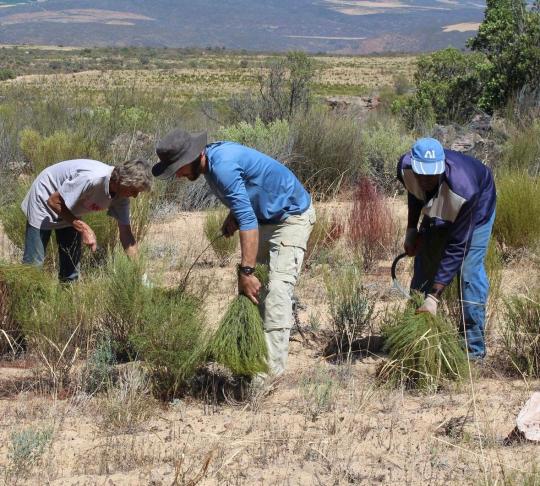
The first to collect leaves and branches of Aspalatus lineara were the indigenous people – the Hottentot people. Only in the 18th century did the Dutch learn about the plant, and then – closer to the 19th century – the British also caught up. The fact of the “discovery” of rooibos for Europeans is attributed to Carl Peter Thunberg, a Swedish naturalist who was in South Africa on behalf of a Dutch company back in the 1700s. The drink was liked by sophisticated society, and at the beginning of the 20th century they began to export it with might and main. Today, the annual production of rooibos is about 12,000 tons, and half of this is exported.

If you are already tired of coffee and tea or need/want to give up caffeine, rooibos is a great option. It quenches thirst well, tones up, is useful for both adults and children, and can also be drunk without sugar. This herbal tea itself contains a sufficient amount of glucose.

Ready! We’ll dry it and sell it. In addition, rooibos contains enough vitamin C, flavonoids, and a number of minerals. In particular, the flavonoid quercetin has antispasmodic, anti-inflammatory, antioxidant and antitumor properties. Some studies show the effectiveness of rooibos against mutagens, CNS damage and free radicals. Although we, of course, recommend that if something happens, contact doctors, and not tea sellers.
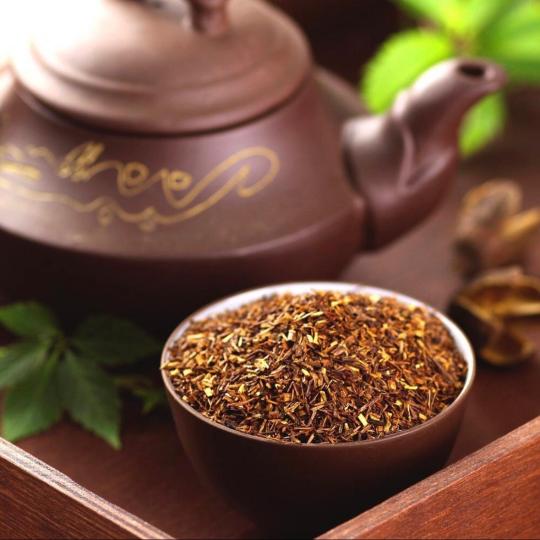
Today you can find this herbal tea in any form: loose, in bags, in pure form and with additives. They even make so-called espresso from rooibos. In general, be sure to try it if you haven’t already!
13 notes
·
View notes
Text

(Warning – graphic depiction of violence)
1492 brought one of the worst calamities to strike the #Jewish people since the destruction of the Second #Temple when Isabella I of Castile and Ferdinand II of Aragon jointly issued the Alhambra Decree (below), requiring all 200,000 #Jews of #Spain to be expelled.
A massive, all-at-once influx of #Sephardic Jews into the diaspora followed.
Some Jews went west and settled in #LatinAmerica. Others went north into #France, #Belgium, and the #Netherlands. Many others emigrated to #Italy, #Greece, #Turkey, Northern #Africa, and the #MiddleEast.
And a large segment of Sephardic Jews moved back to Eretz #Israel, many of whom developed a strong community in Tzfat (Safed), which would play a central role in Jewish life in the #Galilee until the 16th century when it had a population of 15,000 Jews.
In the chaos of the expulsion of hundreds of thousands of Jews, many became desperate realizing they all faced summary execution.
In Jewish desperation, many ship captains saw opportunity for personal gain.
They charged Jews who were trying to leave exorbitant sums. Then, once they collected the Jews’ money and other valuables, those Jews were often tossed overboard to make room for more who would then similarly be fleeced.
The violence was often much more extreme than a simple toss overboard, however.
As rumors spread that Jews had swallowed #gold and #diamonds, they were frequently attacked and knifed to death by brigands, which then searched their stomachs and intestines for treasure.
Captain Allen
22 notes
·
View notes
Text
29.12.2023 | Petitions for the environment and climate change.
Please read, share wherever you can, talk about them and if you can afford it, please, please, please donate - consider taking up a collection among your friends.
Actions.eko.com: Nestlé and P&G: Stop setting Indonesia’s rainforests on fire
Indonesia’s forests are burning – a thick toxic haze suffocates half of the country, keeping children out of school and forcing people and animals to relocate. But it didn’t happen by accident and we know who the arsonists are. Together, we will hold them accountable. Nestlé and Procter & Gamble are doing business with rogue palm oil and paper producers who recklessly burn precious rainforests to the ground to expand their monocultures, steal Indigenous lands, and drive orangutans, rhinos, and elephants closer to the brink of extinction. (keep reading)
Rainforest Action Network - RAN: This one is for donating, they need 100,00$ by December 31!
We urgently need your help to fight for the world's last rainforests in 2024 by making any size donation today. Those who believe they can change the world are the ones that do. Donate now.
Help us challenge mega-corporations like Liberty Mutual, Bank of America, Procter & Gamble, Nestlé and Mondelēz. Their thirst for endless profits contributes to the widespread destruction of irreplaceable rainforests like the Leuser Ecosystem of North Sumatra and the Amazon rainforest and fuels the expansion of dangerous fossil fuel projects that choke the life out of the planet. For a small organization, RAN's significant impact is only possible because of dedicated supporters like YOU. Your generous donation today makes a world of difference.
Rainforest Rescue: DRC: Do not sacrifice Congo's rainforests to the oil industry!
The DRC government in Kinshasa is nearing a point of no return: President Tshisekedi wants to sacrifice vast areas of Congo rainforest and peatland for oil. This would be an unmitigated disaster for the climate, biodiversity and local people. Together with our African partner organizations, we can put a stop to these plans. The rainforests of the Congo Basin are home to millions of people and countless animal and plant species, including chimpanzees, bonobos and gorillas. They are a treasure trove of biodiversity and crucial to the fight against climate change. Despite this, the government of the Democratic Republic of Congo (DRC) began auctioning 27 oil and 3 gas blocks in late July. The blocks cover some of the last remaining intact forests on Earth. Three of the blocks overlap the Cuvette Centrale peatlands, which are estimated to store 30 billion tons of carbon, the equivalent to one years’ worth of global emissions. The peatlands are so vast and remote that little is known about the biodiversity at stake there. Nine oil blocks overlap protected areas. More than half of the Congo Basin's peatlands and 60 percent of its rainforest are in the DRC, the country plays a key role in the fight against the climate crisis. The science is clear: the governments of the world must cut carbon emissions in half within the next eight years. In his speech at the UN's COP26 conference in Glasgow, President Tshisekedi promoted the vital role of the Congo Basin forests in regulating the global climate and his intention to enhance DRC’s energy mix by "combining several types of energy: biomass, hydro, solar." The cost of not doing so, he said, would be a climate crisis. The world cannot afford any further expansion of oil and gas. According to the International Energy Agency (IEA), an immediate end to new investment in fossil fuel supply projects is the first step to keep global warming below 1.5°C and achieve global net zero emissions by 2050. In an alliance of environmentalists from Africa and around the world, we want to keep the oil in the ground and the fossil fuel industry out of the Congo Basin. Please sign our joint petition!
DR Congo: Stop the destruction by miners and loggers in Tshopo!
The Democratic Republic of the Congo is home to the second largest area of rainforest on Earth. Defending it is crucial to the fight against climate change and the extinction crisis. Yet miners are polluting rivers and loggers clearing forests in Tshopo province. In the small town of Basoko, local people are fighting back. The people of the small town of Basoko fear for their health and livelihoods: the Aruwimi River, a tributary of the Congo, has been polluted ever since the Chinese mining company Xiang Jiang Mining began dredging for gold there. Some species of fish have disappeared completely. Skin diseases are on the rise. "We say NO to mining in Aruwimi, which is destroying our ecosystem in an anarchic way," states a memorandum to the county government read during a demonstration. On March 11, 2022, residents of the region protested on land and with boats against the trashing of their environment. Mining is not the only threat to nature in Tshopo province: companies such as FODECO, Congo Futur and SOFORMA are reportedly logging at a breakneck pace near Basoko. "They are systematically plundering the forests without any benefit to local people," says Jean-François Mombia Atuku, chairman of the environmental protection organization RIAO-RDC. "Anyone who demands accountability is silenced," he said, adding that workers are "kept like slaves" in the forest. "Human rights are not relevant for these companies." The grievances regarding mining have been heard in the capital Kinshasa: In January 2022, Environment Minister Eve Bazaiba called on Xiang Jiang Mining to cease operations by February 25, 2022. However, nothing has changed since then – the company is still operating, apparently unimpressed. "What we need now is international pressure," says Jean-François Mombia Atuku. It must be brought to bear on President Tshisekedi, who positioned his country as a heavyweight in the fight against the climate crisis during the COP26 climate conference. It’s time to apply that international pressure – please sign our petition.
#long post#signal boost#environment#climate change#rainforests#Indonesia#Congo#Democratic Republic of Congo#donations#petitions#climate crisis#mining#Congo Basin#COP26#Glasgow COP26#defending the Earth#defending the planet#animal extinction#animal conservation#forest conservation#nature conservation#my posts
9 notes
·
View notes
Text
Mpaca

Image © @chimeride, accessed at their blog here
[Mpaca is a forest spirit in the lore of the Nyange, a people in what is now the Democratic Republic of the Congo who have a rich and mostly still extant oral tradition. The Epic of Mwindo is the most famous of their sagas in English, and Mpaca appears in that story in passing, as a point of reference and comparison. The folktale in which he plays a starring role is collected in The Dictionary of African Mythology, and is online for free . Something I think is interesting is how closely the story “Mpaca’s Very Long Fingernail” maps to the davalpa/himantopus. It is a greedy, parasitic creature that rides on its victims’ backs, and can be defeated by getting it drunk. I’ve talked before about how I don’t hold a lot of stock in diffusionism, but part of me does wonder if the voyages of Sinbad made it to east/central Africa, or Nyange epics made it to the Middle East. There was a lot of trade between the regions, after all.]
Mpaca CR 4 CE Monstrous Humanoid This little man has long, wild hair and long fingers. The middle finger on each hand is extremely long compared to the others, ending in a single claw. His face is elongated, ending in a mole-like snout.
An mpaca is a twisted little humanoid that delights in enslaving other creatures. They can control the behavior of humanoids by jabbing them with their long middle finger, and then ride atop them. They do not treat their slaves well, forcing them to do exhausting work on long hours, and restricting their food and water. An mpaca may even ride such slaves into combat as a mount. Such slaves are controlled repeatedly and often worked to death if the mpaca can manage it.
In seeking out new slaves, an mpaca can shapechange, often favoring the shape of young women and girls. They can also extend their magical fingers to extreme distances, spying on their charges from afar though the nail. If their fingers are severed, the mpaca cannot use its charming ability, and so almost always only extends the finger on one hand and keeps the other in reserve.
Most mpacas live as parasites of humanity, taking over small villages to use as their personal dens of iniquity. The mpaca keeps the community in line with threats and magical charm, alternating between hosts while draining the wealth and happiness from everyone who lives there. When not finding victims, mpacas are lazy and slovenly. They are prone to indulging in drugs and drink, and victims of an mpaca have been known to dislodge the creature by getting it intoxicated.
Mpaca CR 4 XP 1,200 CE Small monstrous humanoid Init +3; Senses darkvision 60 ft., low-light vision, Perception +5, scent Defense AC 18, touch 13, flat-footed 14 (+1 size, +3 Dex, +1 dodge, +3 natural) hp 37 (5d10+10) Fort +3, Ref +7, Will +3 Offense Speed 30 ft. Melee 2 slams +8 (1d4+2 plus grab) or charm claw +8 (3 plus charm) Special Attacks grab (Medium) Statistics Str 15, Dex 17, Con 14, Int 13, Wis 8, Cha 14 Base Atk +5; CMB +6 (+10 grapple); CMD 20 Feats Deceitful, Dodge, Mounted Combat, Undersized Mount (B) Skills Acrobatics +10, Bluff +7, Climb +8, Disguise +7 (+15 using change shape), Perception +5, Ride +14, Stealth +9, Survival +5; Racial Modifiers +4 Acrobatics, +4 Ride Languages Common, Sylvan SQ change shape (humanoid, alter self), probing finger Ecology Environment warm hills Organization solitary or ward (1 plus 1 humanoid) Treasure standard Special Abilities Charm Claw (Su) As a standard action, or as part of an action made to maintain a grapple, a mpaca can jab a humanoid creature with its long clawed finger. A creature so struck must succeed a DC 14 Will save or be charmed for 24 hours. A creature that resists is immune to the charm claw of that mpaca for the next 24 hours. Feats An mpaca’s Undersized Mount feat allows it to ride Medium bipeds without penalty. Probing Finger (Su) An mpaca can extend its middle fingers and see through them. A finger extended in this way can stretch out to 600 feet long, extending or retracting as much as 30 feet a round. The mpaca can see and hear through the finger, and make charm claw attacks with it. While using its finger in this fashion, the finger can make Stealth checks as if it were a Diminutive creature, and fit through cracks as narrow as 1 inch. The mpaca can still use its normal senses while extending a finger in such fashion, but it is distracted; treat the mpaca as being flat footed. The finger can be destroyed through damage (AC 18, 5 hp, DR 5/bludgeoning or slashing). An mpaca regrows a destroyed finger over the course of 1 month, and if both of its fingers are destroyed, it cannot make charm claw attacks.
#mpaca#nyange#mwindo epic#african folklore#african mythology#chimeride#original art#pathfinder 1#world tour
104 notes
·
View notes
Text
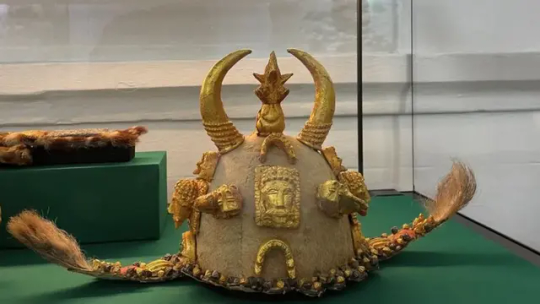
A ceremonial cap worn by courtiers at coronations is among the items now on display in Kumasi
African countries have repeatedly called for the return of looted items with some regaining ownership over precious historical artefacts in recent years.
Looted artefacts from the Asante kingdom are finally on display in Ghana, 150 years after British colonisers took them.
Ghanaians flocked to the Manhyia Palace Museum in Kumasi, the capital of Asante region, to welcome the 32 items home.
"This is a day for Asante. A day for the Black African continent. The spirit we share is back," said Asante King Otumfuo Osei Tutu II.
At this stage the items have only been loaned to Ghana for three years.
This loan can be extended, but only with the approval of the British culture secretary.
The agreement is between two British museums - the Victoria & Albert Museum (V&A) and British Museum - and the Asante king, not the Ghanaian government.
The Asante king, or Asantehene, is seen as a symbol of traditional authority, and is believed to be invested with the spirits of his predecessors. But his kingdom is now part of Ghana's modern democracy.
"Our dignity is restored," Henry Amankwaatia, a retired police commissioner and proud Asante, told the BBC, over the hum of jubilant drumming.
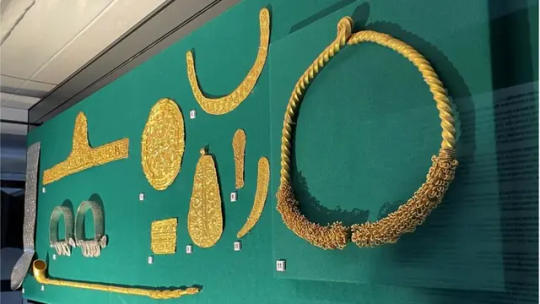
The neck ring or 'kanta' (R) was worn by the king at important funerals
The V&A is lending 17 pieces while 15 are from the British Museum.
The return of the artefacts coincides with the silver jubilee celebration of the Asantehene.
A guide to Africa's 'looted treasures'
UK to loan back Ghana's looted 'crown jewels'
Some of the items, described by some as "Ghana's crown jewels" were looted during the Anglo-Ashanti wars of the 19th Century, including the famous Sargrenti War of 1874.
Other items like the gold harp (Sankuo) were given to a British diplomat in 1817.
"We acknowledge the very painful history surrounding the acquisition of these objects. A history tainted by the scars of imperial conflict and colonialism," said Dr Tristam Hunt, director of the Victoria and Albert Museum, who has travelled to Kumasi for the ceremony.

The display is part of the silver jubilee celebrations of Asante King Otumfo Osei Tutu II
Among the returned artefacts are the sword of state, gold peace pipe and gold badges worn by officials charged with cleansing the soul of the king.
"These treasures have borne witness to triumph and trials of the great kingdom and their return to Kumasi is testament to the power of cultural exchange and reconciliation" said Dr Hunt.
One of the returned items, the sword of state, also called the "mpompomsuo sword" holds great significance for the Asante people.
It serves as a sword of office that is used in swearing the oath of office to the kingdom by paramount chiefs and the king himself.
Royal historian Osei-Bonsu Safo-Kantanka told the BBC that when the items were taken from the Asante it took away "a portion of our heart, our feeling, our whole being".

This gold headpiece known as "krononkye" was used when royalty was grieving

The midnight knife (L) was used for covert operations. The gold badges (R) were worn by the king's soul washers
The return of the artefacts is as controversial as it is significant.
Under UK law, national museums like the V&A and British Museum are banned from permanently giving back contested items in their collections, and loan deals such as this are seen as a way to allow objects to return to their countries of origin.
Some countries laying claim to disputed artefacts fear that loans may be used to imply they accept the UK's ownership.
Many Ghanaians feel the ornaments should remain permanently. However, this new arrangement is a way to overcome British legal restrictions.
African countries have repeatedly called for the return of looted items with some regaining ownership over precious historical artefacts in recent years.
You may also be interested in:
Top Belgian museum rethinks its Africa relationship
'My great-grandfather sculpted the Benin Bronzes'
France gives back sword of anti-colonial fighter
#ghana#looted gold#loaning ghana their artifacts#uk stolen legacy of Ghana#stealing gold and diamonds#uk you do not own these things#give them back#white lies#black lives matter
4 notes
·
View notes
Note
Dear Vector Prime, besides the trio of Blood, Dauros and Gilmer was ancient Earth plagued by any other Decepticon Pretenders?
Dear Pretender Peeved,
Oh, certainly—the Autobots spent centuries trying to corral them. You may already be aware of Bludgeon and his fellow Pretenders’ rampage through ancient Japan; these Pretenders ranged across the entire world, so you may be interested to learn about their feats and fates.
Bludgeon likes to claim to have taught humanity the art of war, providing weapons and armor to various groups, relishing in the bloodshed and chaos he caused. The Autobots sealed him away on many occasions, but his final sealing took place in the 10th century. He had teamed up with a sorceress who sought revenge on the slayers of her father, and her magical manipulations multiplied the mystic Metallikato might of Bludgeon's Pretender shell. He was eventually sealed away under what would eventually become the city of Tokyo.
Iguanus rampaged across early Europe, seizing whatever he could from the tribes who lived there. He was finally sealed away under Stonehenge by Metalhawk and the other Autobot Pretenders, although they never discovered Iguanus' treasure hoard—not that they made any particular attempt to reclaim his collection of trinkets, busy as they were keeping humanity safe.
Stranglehold maintained a petty kingdom in Northern Africa, using his impressive physical might and near-invulnerability to maintain control over those nearby. He especially enjoyed wrestling with humans, viewing them as pitiful challengers. In the end, one such pitiful challenger managed to defeat Stranglehold by getting him in a Cobra clutch. In shame, Strangehold abandoned his kingdom, and wound up in the crosshairs of the Autobots, who sealed him beneath the Atlas Mountains.
Carnivac and Snarler terrorized the lands of Arcadia, causing havoc and famine as they destroyed whatever civilizations tried to intrude into their wilderness domain. Their teamwork kept them undefeated until the Autobot Pretenders teamed up as well, separating and binding them between a pair of mountains.
Octopunch was the least active of the Decepticon Pretenders, preferring to keep watch over the slumbering form of his master, Devil Z. To avoid the Autobots, he ventured out only when he was in dire need of resources, raiding ships while proclaiming the might of the Decepticon god he served. In the end, the Autobots managed to lure him into a trap off the Ryukyu Islands, sealed beneath a collection of sandstones.
#ask vector prime#transformers#maccadam#japanese generation 1#pretenders#bludgeon#metallikato#iguanus#stonehenge#metalhawk#stranglehold#cobra#carnivac#snarler#octopunch#devil z#alex-lemonds-93
18 notes
·
View notes
Text
Nintendo Partner Showcase February 2024
Honey, Microsoft Shrunk the Kids (Grounded)
Full Metal Alchemist X Neir Automata (Ender Magnolia: Bloom in the Mist)
The Cha Cha Slide, Part 5 (Arranger: A Role-Puzzling Adventure)
Final Emblem: Ogre Saga (Unicorn Overlord)
I think this is what people expect from Pokémon for some reason (Monster Hunter Stories)
DISNEY EPIC MICKEY REBRUSHED
V for Vendetta DLC (Shin Megami Tensei V: Vengeance)
Bond With Your [Younger/Older] Brother! (Star Wars Battlefront Classic Collection)
Fart of the Wild (South Park: Snow Day)
Hyperlight Kirito [with 20 player co-op] (Sword Art Online Fractured Daydream)
Armored Core 7 (Gundam Breaker 4)
Do You Think Surgeons Will Also Use This As Practice? [with 16 player co-op] (Super Monkey Ball Banana Rumble)
Slime Tiktok Meets Engineering Tiktok (World of Goo 2)
Dark Cloud 3: Animal Crossing [with 4 player co-op] (Fantasy Life i: The Girl Who Steals Time)
Are You Telling Me A Hermit Crabbed This Shell? (Another Crab's Treasure)
Circus Celeste (Penny's Big Breakaway)
Didn't Alpharad Already Do This? (Suika Game 2-Player Battle Paid DLC)
Drill-y Kong Country (Pepper Grinder)
They Put Gambling In My Solitaire (Pocket Card Jockey: Ride On!)
Hey Tumblr, Can You Tell Me About This In A Sane Manner? (Snuffkin: Melody of Moominvalley)
2D Africa Platformer (Tales of Kenzera: ZAU)
Demon Slayer Mario Party (Demon Slayer -Kimetsu no Yaiba- Sweep the Board!)
Skyrim Again (Kingdom Come Deliverance - Royal Edition)
Don't Forget the Konami Code (Contra: Operation Galuga)
Ye Olde Disco Elysium (Pentiment)
Game Grumps: Return to Nine-Ball Island [with 30 player co-op] (Endless Ocean Luminous)
#Nintendo Direct#nintendo switch games#endless ocean#ender magnolia#unicorn overlord#monster hunter stories#epic mickey#star wars battlefront 2#world of goo#super monkey ball#fantasy life i#penny's big breakaway#pepper grinder#suika game#shin megami tensei#arranger#gundam breaker 4
4 notes
·
View notes
Text
CROB Profile: 🐛 Centipede Cookie
Warning: This Cookie’s content may be offensive and/or Orientalist due to Devsisters’s mishandling of Middle-Eastern themes and the extent of SWANA (Southwestern Africa and North Africa) cultures as they published more parts of the Yogurca theme. I will try my best to publish the content of this Cookie on a purely gameplay-centric basis while only providing extra content based on storylines in the game itself as part of my obligation as a Cookie Run information archive blog. Cookie commentary will be cut from all posts on this theme. As such, I do not support Devsisters in their handling of these themes as it stands now. I would rather see them have a do-over, or to have somebody else who knows more about the subject of SWANA cultures audit the company’s work to ensure that the Yogurcan theme is not mishandled again beyond anything that has already been published. If I make a mistake on this subject, respectfully report any specific problems seen in this post (and any further linked posts) to me ASAP so that it may be corrected.
Centipede Cookie is an Epic Cookie who was released alongside her Pet Treasure Flask on March 28th, 2023 as part of the update “In the Shadows of the Dunes” as the first of the update’s two new Cookies. As explained by Chapter 1 of the “Village of Mirages” event, she appears to be vying for leadership of the Sneaky Sands Clan when the old leader steps down, and subsequently brands Lilac Cookie as a traitor since he left the clan.

Release Date: March 28, 2023
Tags: #Speed #Jellies #SpecialControl
Rarity: Epic
Energy: 176 + 9 per level (266 Trial at Level 11, Max 302)
Resonant Ingredient: Golden Sun Necklace
Pronouns: She/Her
Unlock Condition: 758 Trial Star Jellies OR 2,900 Crystals
Affection Bonuses: +1,000 / +2,000 points for Treasure Jellies
Titles:
454. Ooh Ho Ho! (Upgrade Centipede Cookie to level 15)
453. Sneaky Sands Clan, Assemble! (Reach Diamond in Centipede Cookie and Peppercorn Cookie’s Trials)
Banned in CotMT?: Unknown
Raid Run Skill: Not Qualified

In-Game Story
"Ohh ho ho!" If you hear this piercing laughter... you better run! Or else you will have to face Centipede Cookie's giant centipede bursting from the ground right before you. Sitting on the head of the giant centipede, smirking down at other Cookies, this Cookie always desires to be the center of attention. Like her tail, Centipede Cookie wields a vibrant whip, and quite a few Cookies look up to her skillful powers. The Cookie has been waiting long for the day to rise victoriously. By the look of all the golden accessories she buys, perhaps the Cookie wanted to be rewarded for the long wait.
Skill
Starts riding the Centipede King at given intervals. Treasure jars appear, which can be broken by the Cookie's whip. Press the whip button when a jar is in range to destroy it and create Treasure Jellies. Level Up for more points and Coins for Treasure Jellies.
Centipede Cookie will periodically summon the Centipede King to ride on top of it. While the Centipede King is active, she can encounter Treasure Jars moving left towards her. Press the “Whip” button while a Treasure Jar is in the red targeting zone denoted by the two dotted lines (and highlighted by a set of crosshairs) to destroy it using her whip, releasing the Treasure Jellies and Coins inside. A Treasure Jar is counted as a “Miss” if it moves left outside of the red targeting zone. The whip attack can destroy obstacles in the targeting zone, while the Centipede King will destroy obstacles by moving into them. Centipede Cookie will have a basic magnetic field while the Centipede King is active, and she can still jump and double-jump from atop the Centipede King to achieve other objectives such as collecting static/winged jellies or destroying other obstacles for points.
⏳ Skill Delay: 29.2 seconds
⏰ Observed Skill Duration: 11.02 seconds
🏺 Treasure Jars Per Skill: 7
💎 Treasure Jellies Per Treasure Jar: 10 x 7 (70 Total, 40 with Magic Candy)
💎 Treasure Jelly Score: 95,000 + 12,500 per level (220,000 Trial, 270,000 Max)
🪙 Coins per Treasure Jelly: 10

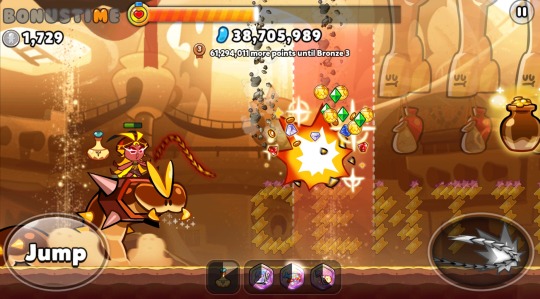
Magic Candy

Some of the treasure jars turn into Splendorous Jars. Splendorous Jars contain Splendorous Treasure Jellies. The stronger the enchanted effect, the more points and Coins for Splendorous Treasure Jellies.
With her Magic Candy, three random Treasure Jars in one skill cycle are replaced with Splendorous Treasure Jars. Destroying these jars will release Splendorous Treasure Jellies worth more points and Coins than regular Treasure Jellies.
🏺 Splendorous Treasure Jars Per Skill: 3
💎 Splendorous Treasure Jellies Per Splendorous Treasure Jar: 10 x 3 (30 Total Replaced)
💎 Splendorous Treasure Jelly Score: 156,000 + 68,500 per level (390,000 Max)
🪙 Coins Per Splendorous Treasure Jelly: 30
✨ Blessings: Yellow Bear Jellies, Pink Bear Jellies, All Bear Jellies, Coins
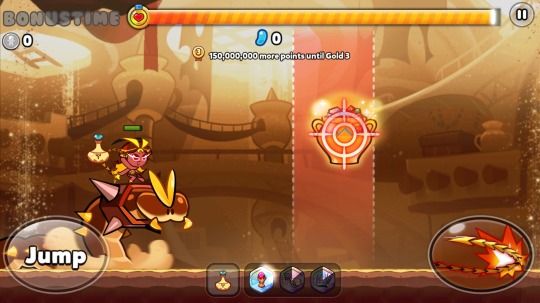
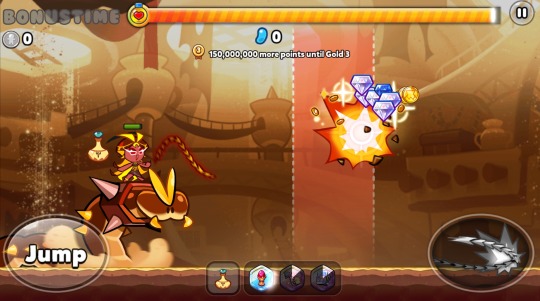
Relationships
Lilac Cookie: I trusted you... 🔥 Rival
Scorpion Cookie: Wipe that smirk off your face, traitor! ⚡️Tension
Tiger Lily Cookie: The Centipede King is cooler than your Butter Tiger! 👍 Friendly
Skating Queen Cookie: Ohh ho ho! You're very confident, like me! 👍 Friendly
Adventurer Cookie: Lucky Cookie who didn't face any troubles in the Mirage Village! ⚡️ Tension
Yogurt Cream Cookie: It's always a failed mission when this Cookie is involved!!! ⚡️ Tension
Combi Bonuses
Treasure Flask: +220,000 Points for Treasure Jellies
Pop Pop Photocard: +240,000 Photocard Collection Points
Costume
Sun-Blessed Hotshot (+1,500 Treasure Jelly Points) When the whip soars high into the sky and soaks in the sunlight, it's game over! The outfit may seem a little light for going into a harsh battle, but don't be fooled as Centipede Cookie has all the skills to win any battle. The Cookie claims to have been blessed by the sun and maybe... just maybe it is true!
Release Date: March 28, 2023
Rarity: Champion
This costume was only available during the Centipede Season of the Champions League for 2,400 Season Points.

Conclusion
Centipede Cookie is a low-end Coin generator for her skill (700 without MC -> 1,300 with MC), but with a few extra coins on the map, she can reasonably benefit from skills and features that require Coins to activate, such as the Ion Microchip, her combi Treasure Pop Pop Photocard, Energy Scale, Panda Dumpling, and in-map shops. As such, she would not be recommended to farm Coins. However, the bonus speed she gets from her skill, combined with her magnetic field, moderate jelly creation, and large destruction hitbox, allows her to clear large areas of the map while destroying every obstacle in her path and collecting almost every jelly along the way while her skill is active. Running with the Paradise Compass will turn this magnetic field into a Super Magnetic Field that can attract otherwise winged/un-attractable Rainbow Bear Jellies, ensuring that EVERYTHING in range gets collected by the magnet with less effort to jump into them manually. This area sweeping range can be extended with speed Treasures like the X-tra Hot Turbo Engine and Lollipop Skate, as well as a well-timed Blast from countless sources.
Intended to be paired with Treasure Flask’s energy conservation skills, Centipede is built for moderately-long hauls across the map before she stops. Utilize and boost her speed to cover as much ground as possible with her massive skill hitbox, and utilize the Coins she generates for extra bonuses to maximize your score as much as possible.
#cookie run#crepe archives#cookie run ovenbreak#cookies#speed#jellies#special control#centipede cookie#tw orientalism#yogurca discourse
8 notes
·
View notes
Text






The Nile Valley civilization belongs to the indigenous African peoples in Africa Lady Isis Isis... Isis is pronounced in Greek, but in the language of the inhabitants of the ancient Nile Valley civilization, it was pronounced "est". Isis was the complete female, so she was rightfully the "six". In the eternal Egyptian myth, "Isis and Osiris", the six Isis received metaphysical sciences from Thoth and collected the parts of her murdered husband, Osiris. With that science, she was able to bring him back to life again, so she was called the Egyptians. The ancients called her "the great one in magic" (meaning the master of metaphysical sciences). The six is the highest stage of maturity for the female when she reaches wisdom, so the “six” is the wise mature woman. The stages of female development are: Bastet: a child Hathor: a girl Sekhmet: a woman
Wise When we notice that many African groups, especially, wear cow horns on their heads while dancing in their celebrations, and this confirms that the products of the Egyptian civilization are quant, their origin belongs to all the peoples of the Nile and the desert, and they are the ones who founded and left us these treasures The Battle of African Consciousness
18 notes
·
View notes
Photo

Are the Benin Bronzes Made From German Brass—And Does It Matter? On a humid February day in 1897, with smoke from relentless shelling hanging heavy in the royal city, the invading force advanced. More than a thousand British soldiers, bolstered by auxiliary troops, attacked the centuries-old seat of the forest kingdom, among the most powerful in West Africa. England would claim the military operation was retaliation for the killings of a few of its citizens after they violated the kingdom’s sovereignty. But in truth, it was a ruthless assault to vanquish the Kingdom of Benin and gain control of its wealth. By the time it was over, Benin City was in ashes. Amid the untold civilian casualties, destruction of homes, and other brutalities, the invaders looted thousands of royally-commissioned figures, masks, plaques, and other objects, some carved from wood or ivory but most cast in brass or bronze. Collectively known today as the Benin Bronzes, these treasures were hauled to the coast, loaded onto ships, and, eventually, made their way to some of the most famous museums and private collections in Europe and the United States. There, for more than a century, the Benin Bronzes were displayed, often without mention of their significance as religious or commemorative objects. More recently, as the importance of the Benin Bronzes as cultural heritage has been more broadly acknowledged, the magnificently detailed faces and intricate scenes of royal life have been at the center of often-heated political, cultural, and legal debates over repatriation and reparation for their violent theft. Now, there’s a new wrinkle in the story. Published today in the journal PLoS One, a novel geochemical analysis suggests that the raw material used in the production of Benin’s famous metalworks came from Rhineland, in western Germany. The findings are a scientific first, but the bigger question is: Does it matter where the metal came from? “I don’t think this is of enormous interest to the Edo people themselves. Where the material originally came from is a bit neither here nor there,” says Barnaby Phillips, journalist and author of Loot: Britain and the Benin Bronzes. (The term "Edo" can refer to both the historic kingdom of Benin, also known as the Benin Empire or Edo Empire, and the modern Nigerian state, located at what was the heart of the ancient kingdom; some experts prefer to use the term Edo to distinguish the kingdom and its people from the modern country of Benin, to the west of Nigeria.) Perhaps the most interesting thing about the paper is its method: The team compiled data from previously published analyses of metals used in objects considered Benin Bronzes, and compared those results with new analysis of something perhaps unexpected: artifacts retrieved from shipwrecks. Specifically, the team analyzed the composition of dozens of objects called manillas, retrieved from five shipwreck sites around the Atlantic and three archaeological sites in West Africa and Europe. Manillas are small, c-shaped pieces of brass that were manufactured in Europe and used by Portuguese traders as currency along much of the West African coast from the late 15th to the 19th century. All of the manillas analyzed in the study came from sites or shipwrecks, from Massachusetts to Sierra Leone, that had ties to Portuguese trade during this era. After comparing the previously published chemical signatures of the Benin objects with those of the manillas and an established database of European ores, the researchers concluded that “this study definitively identifies the Rhineland as the principal source of manillas.… Millions of these artifacts were sent to West Africa where they likely provided the major, virtually the only, source of brass for West African casters between the 15th and the 18th centuries.” It’s the first time anyone has tied the raw material ultimately used to produce the Benin objects to a specific geographic area—but a European origin for the material is not a surprise to scholars familiar with the Benin Bronzes. “A significant part of the metal that constitutes Benin bronze came from Europe. It’s only natural to start with the Portuguese connection [when researching its origin],” says Ndubuisi Ezeluomba, curator of African art at the Virginia Museum of Fine Arts in Richmond. Ezeluomba, who has written extensively about the objects from an arts management perspective, says he found the paper “exciting,” but would like to see more details. Despite the new paper’s emphasis on a German origin for the raw material Benin artists used, brass objects had been produced in West Africa long before European contact. While some regional metalworking traditions lasted for a century or two, the Kingdom of Benin’s casters were at work for at least 500 years, and possibly much longer. “What helped in the Benin case was it was under the control of the king, he was the sole patron at that time,” says Ezeluomba. “These were not objects made for the ordinary person. They were made to beautify the palace and decorate royal shrines. All the plaques you see were just like normal photographs, put on the palace wall to decorate them.” Despite its longevity—or perhaps because of it—the very roots of Benin’s bronze and brass casting tradition remain a mystery, and a source of contention between people in today’s Edo state and surrounding regions, notably the Yoruba people to the northwest, many of whom have ancestral ties to the ancient Ife Kingdom. The dates of manufacture for many of the items are also uncertain or contested. “There is a great historic rivalry between the Ife and Benin kingdoms, and there is a great deal of sensitivity as to which came first and which influenced the other,” says Phillips. “[But] the Ife civilization is producing these amazing objects, certainly predating contact with the Europeans.… Of course, Edo historians are adamant that their own metal casting tradition, be it bronze or brass, predates the arrival of the Europeans.” One thing researchers, historians, and curators alike agree on: “The arrival of the Europeans is a catalyst for expanded production,” says Phillips, adding that the sudden and substantial availability of brass, in the form of manillas, would have given the Benin artists much more material to work with. The paper’s lead author and designated media contact Tobias Skowronek declined interview requests for this story. Skowronek is a geochemist at the Technische Hochschule Georg Agricola in Bochum, near Dusseldorf and coincidentally close to the area where his team believes the raw material for the Benin Bronzes was mined. Some feel the new research may be less about a scientific breakthrough and more about researchers wanting to participate in some way in the broader discussion of the objects, currently a popular topic on social media and elsewhere. “The Benin Bronzes have become emblematic of the debate around colonial looted art for a couple of reasons. The first reason is that they are very fabulous, [and] the way in which they were taken was particularly egregious,” says Phillips. “And if you’re more or less anywhere between Seattle and Stockholm, there are Benin Bronzes in your nearest museum. So it has great resonance in different countries and has fitted into the postcolonial discourse.” It’s unclear what, if any, impact the new paper may have on ongoing political and legal maneuvering around efforts to return the artifacts to Nigeria. While museums in some countries, notably Germany, have already returned dozens of the objects or have committed to do so, some opposition continues. In 2022, the Restitution Study Group (RSG), which describes itself as a nonprofit concerned with slavery justice, launched a legal challenge to the Smithsonian Institution’s transfer of ownership of several objects to the Nigerian government. RSG’s argument is that the Benin Bronzes are culturally significant to descendants of enslaved people in the United States, and should remain accessible to them, because they were cast from melted-down manillas that Europeans traded with Benin nobility “in exchange for abducted and enslaved neighboring non-Beni people.” ("Beni" or "Bini" is another name for the language, also known as Edo, spoken in the kingdom.) While a judge denied RSG’s attempt to stop the transfer in October, the legal battle points to a question of much greater significance than where the metal in the Portuguese manillas was mined: “To put it crudely, to what extent were these [manillas] being traded for slaves?” says Phillips. The answer, based on historical evidence, appears to be that the Kingdom of Benin had fewer connections to the transatlantic slave trade than other regional kingdoms. “The history of how those things were removed, that’s what gets me.” Phillips notes that the forest kingdom, which was inland and not directly accessible to ships involved in the slave trade, had significant natural resources and industries, such as palm oil, ivory, and textiles. “I think Edo historians are on to something when they say their own kingdom was a lot more powerful than many of the other kingdoms that Europeans engaged with, and crucially had other things the Europeans wanted to buy,” he adds. While the links between the slave trade and the manillas melted down for the casters’ use remain uncertain and controversial, the brutality with which the Benin Bronzes were taken is incontrovertible. Ezeluomba, who grew up in modern Benin City, says he considers the objects as art, and studies them with professional detachment. However, he adds, “The history of how those things were removed, that’s what gets me. The sheer scale of the human casualties that these guys unleashed on Benin, the number of bullets that came out of those machine guns, those are the facts that actually get me.… It was very brutal. I always have that in the back of my mind.” For advocates of the return of the Benin Bronzes to what is now Nigeria, repatriation is a start, but only the first step in what must be a thoughtful process of remediation. Ezeluomba says it’s not just about returning the stolen goods to Benin City; Western museums, governments, and scholars should assist in infrastructure building, training, and other initiatives that will preserve the items for generations to come. Considered in this broader context, the question of whether the Benin Bronzes were cast from material mined in western Germany is a footnote. “If a Nigerian artist buys all their paints and canvas from Europe, is it European art?” Ezeluomba asks. “It’s not about the materials, it’s about who made the work.” https://www.atlasobscura.com/articles/benin-bronze-origins
8 notes
·
View notes